HiVizGard™
Safety gear and high visibility gear
Enhance workplace safety with HiVizGard™ Hi-Vis Apparel from Liberty Safety. Our hi-visibility clothing is designed to signal workers’ presence to drivers and vehicle operators, especially in low-light and dark environments. Combining comfort, style, and functionality, our hi-vis gear features reinforced cross-stitching, zipper stitching, breathable fabrics, heavy gauge mesh, and black-bottom tops and pants. Experience top-tier protection with HiVizGard™ Hi-Vis Accessories and explore our extensive Non-ANSI, Class 2, Class 3, and Class E hi-vis apparel collection. No matter the job, we…
Enhance workplace safety with HiVizGard™ Hi-Vis Apparel from Liberty Safety. Our hi-visibility clothing is designed to signal workers’ presence to drivers and vehicle operators, especially in low-light and dark environments. Combining comfort, style, and functionality, our hi-vis gear features reinforced cross-stitching, zipper stitching, breathable fabrics, heavy gauge mesh, and black-bottom tops and pants.
Experience top-tier protection with HiVizGard™ Hi-Vis Accessories and explore our extensive Non-ANSI, Class 2, Class 3, and Class E hi-vis apparel collection. No matter the job, we have the right gear for you. Learn about the ANSI/ISEA 107-2020 standard, the authoritative guideline for the design, performance, and materials of high-visibility PPE.
Choose the right hi-vis gear for your specific hazards by considering your work type, lighting conditions, and traffic flow. Fluorescent materials enhance daytime visibility, while retroreflective materials improve visibility in low-light conditions. Keep your workforce safe with Liberty Safety’s reliable and comfortable hi-vis reflective safety apparel.
- HIVIZGARD™ Non-ANSI Hi-vis Apparel
- HIVIZGARD™ Class 2 Hi-vis Apparel
- HIVIZGARD™ Class 3 Hi-vis Apparel
- HIVIZGARD™ Class E Hi-vis Apparel
- HIVIZGARD™ Hi-Vis Accessories
Showing 1–20 of 45 results
-
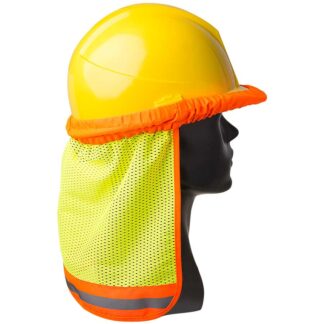 NS161
NS161HiVizGard™
Cap Style Neck Shade
-
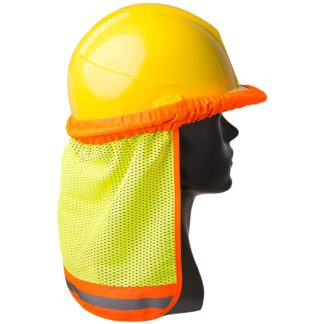 FRNS161G
FRNS161GHiVizGard™
Chemically Treated FR Neck Shade
-
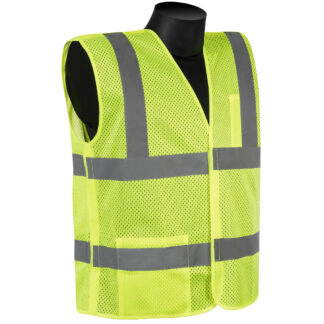 C16005
C16005HiVizGard™
Class 2 5-Point Breakaway Vest
-
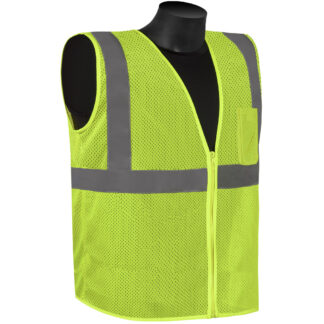 FR16002
FR16002HiVizGard™
Class 2 Chemically Treated FR Economy Vest (All Mesh)
-
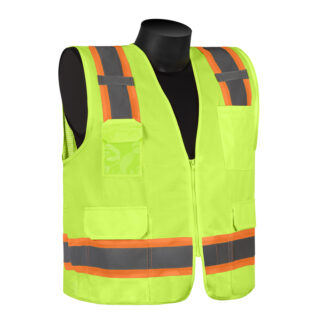 FR16012G
FR16012GHiVizGard™
Class 2 Chemically Treated FR Surveyor Vest
-
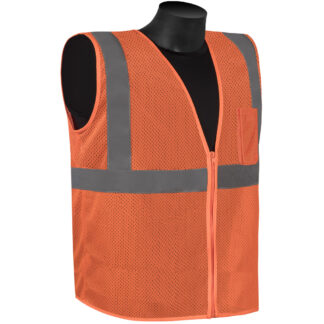 C16002F
C16002FHiVizGard™
Class 2 Economy Vest
-
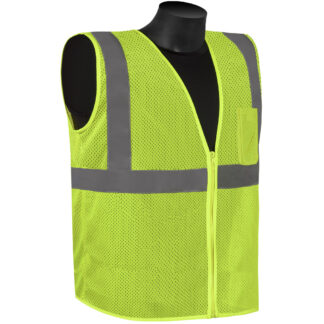 C16002G
C16002GHiVizGard™
Class 2 Economy Vest
-
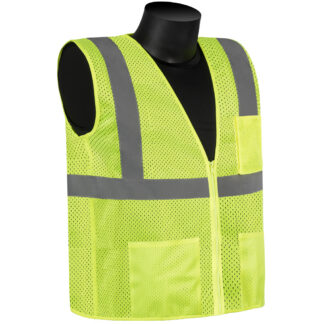 C16003
C16003HiVizGard™
Class 2 Economy Vest (All Mesh)
-
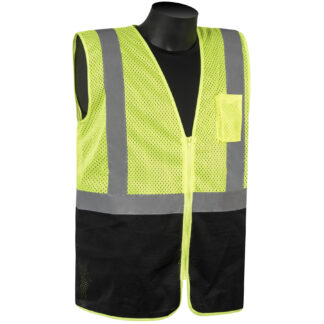 C16002QGB
C16002QGBHiVizGard™
Class 2 Economy Vest With Black Bottom
-
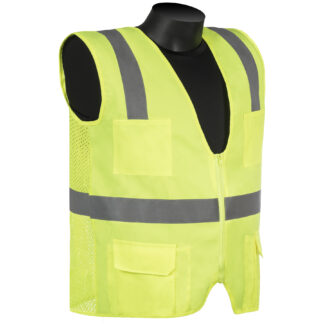 C16010
C16010HiVizGard™
Class 2 Engineer Surveyor Vest (Solid Front Mesh Back)
-
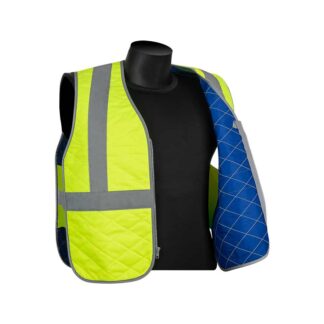 C16006GC
C16006GCHiVizGard™
Class 2 Evaporative Cooling Vest
-
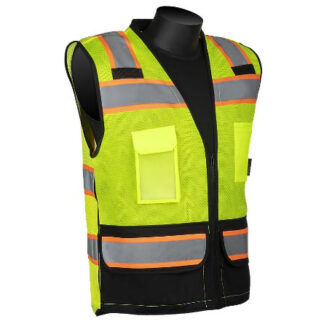 C16042
C16042HiVizGard™
Class 2 Foreman Surveyor Vest With Black Bottom
-
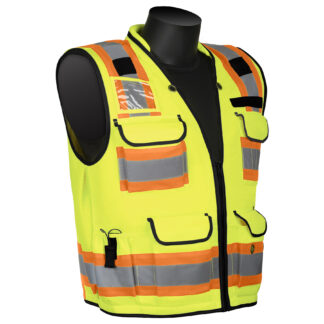 C16016G
C16016GHiVizGard™
Class 2 Heavy Duty Surveyor Vest
-
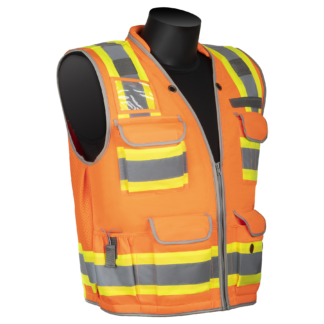 C16016F
C16016FHiVizGard™
Class 2 Heavy Duty Surveyor Vest
-
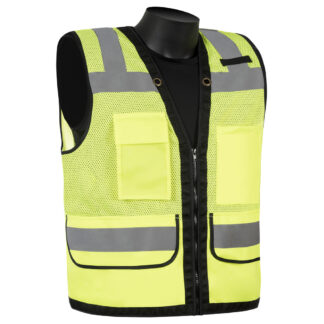 C16032G
C16032GHiVizGard™
Class 2 Surveyor Vest (All Mesh With Solid Bottom)
-
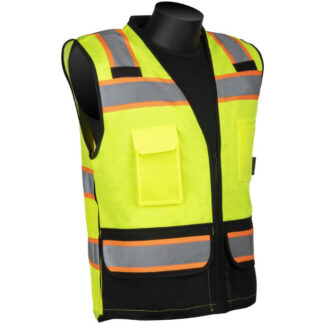 C16032B
C16032BHiVizGard™
Class 2 Surveyor Vest With Black Bottom
-
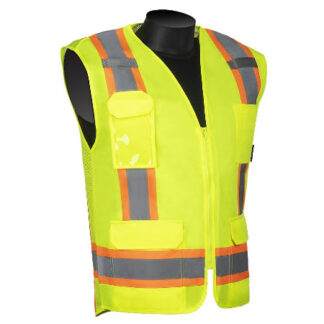 C16017G
C16017GHiVizGard™
Class 2 Two-Tone Surveyor Vest
-
 C16017F
C16017FHiVizGard™
Class 2 Two-Tone Surveyor Vest
-
 C16013G
C16013GHiVizGard™
Class 2 Two-Tone Surveyor Vest (All Mesh)
-
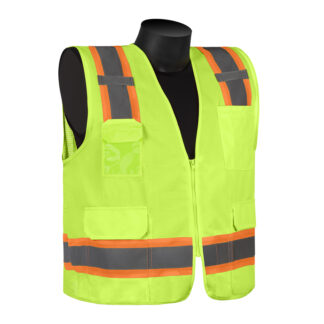 C16012
C16012HiVizGard™
Class 2 Two-Tone Surveyor Vest (Solid Front Mesh Back)
FAQ
High-visibility safety apparel (HVSA) is pivotal in mitigating risks for workers, particularly in low-light or dark conditions. This specialized protective gear, including jackets, pants, vests, and sweatshirts, is designed to enhance visibility and reduce the likelihood of accidents. HVSA incorporates reflective and fluorescent materials, making workers more conspicuous to motorists and equipment operators.
Reflective materials, a key component of HVSA, work by redirecting light back to its source. This property makes them particularly effective in low-light conditions, as they bounce back light from headlights or other light sources, making the wearer more visible. On the other hand, fluorescent materials in HVSA rely on bright light, functioning optimally when there is a source of sunlight. Fluorescent HVSA is most effective in bright light conditions.
HVSA is widely used in various work environments, including construction sites, warehouses, maintenance facilities, and traffic zones. Equipping your team with HVSA ensures their safety and well-being amidst hazardous work conditions.
The American National Standard for High-Visibility Safety Apparel and Accessories (ANSI/ISEA 107-2020) is the fourth edition of the industry consensus standard for High-Visibility Safety Apparel (HVSA) in occupational settings.
ANSI/ISEA 107-2020 maintains a Type-Performance Class designation for garments, with the Type based on the expected use setting and the Performance Class identified by the visible materials and design attributes in the finished garment.
There are four garment performance classes:
- Class 1
- Class 2
- Class 3
- Class E
And three Garment Types based on expected Work Environments:
- Type O (“Off Road”): Type O HVSA is a performance class 1
- Type R (“Roadway”): Type R HVSA may be performance class 2 or 3
- Type P (“Public Safety/ First Responders”): Type P HVSA may be performance class 2 or 3
The chart below details each garment type and performance class, specifying the minimum areas for background material, retroreflective or combined performance materials, and the minimum reflective material width.
|
Garment Type
|
Performance Class | Background Material
|
Retroreflective or Combined Performance Materials |
Minimum Width Reflective Material |
| Type O Off-road and Non-Roadway Use | Class 1 | 217 in² | 155 in² | 1 in. |
| Type R Roadway and Temporary Traffic Control Zones |
Class 2 | 775 in²* | 201 in² | 1.38 in. 1″ split trim designs |
| Class 3 | 1240 in²** | 310 in² | 2 in. 1″ split trim designs |
|
| Type P Emergency and Incident Responders and Law Enforcement Personnel |
Class 2 | 450 in.² | 201 in² | 2 in. 1″ split trim designs |
| Class 3 | 775 in² | 310 in² | 2 in. 1″ split trim designs |
|
| Supplemental Items Pants, Overalls, Shorts, Rain Pants and Gaiters |
Class E | 465 in² | 109 in² | 2 in. 1″ split trim designs |
| *For the smallest size offered in Type R, Class 2, a minimum of 0.35m² (540 in²) of background material may be used to accommodate small-sized workers. All subsequent larger sizes must use 0.50 m² (775 in²).
**For the smallest size offered in Type R, Class 3, a minimum of 0.65 m² (1,000 in²) of background material may be used to accommodate small-sized workers. All subsequent larger sizes must use 0.80 m² (1240 in²). |
||||
OSHA recommends that a hazard assessment be carried out on each job site to evaluate the workplace or worksite and determine possible hazards that could be encountered on the job. An assessment includes asking questions like:
- What is the type and nature of the work carried out – including the tasks of both the HVSA wearer and any drivers?
- What are the conditions during work?
- Will it be indoor or outdoor work?
- What’s the temperature?
- How busy is the traffic flow?
- How many other workers will be there?
- How long will various traffic hazards be an issue?
- What are the lighting conditions, and will they change during the work shift? (For example, will it be sunlight, an overcast sky, fog, rain, or snow?)
- Will traffic volume, vehicle sizes, speeds, and stopping conditions be an issue?
- Will any hazard controls already exist (e.g., barriers, traffic cones, etc.)?
- What distractions might occur that would draw workers’ attention away from hazards?
- What are the sightlines for vehicle operators?
With the information gathered from a full assessment, the worker can select the proper high-visibility PPE. Using high-visibility safety apparel helps defend against accidents by providing more warning to others working in the same area.
Fluorescent material uses unique pigments to send light back to a viewer, making it even more visible. It can only function properly when there is natural sunlight. Fluorescent clothing appears brighter than the same-colored non-fluorescent material, especially under low natural light (e.g., cloud cover, fog, dusk, dawn, etc.). It’s a property that offers daytime visibility enhancement not found with other colors. Fluorescent colors provide the most significant contrast against most backgrounds. They also enhance daytime visibility, especially at dawn and dusk.
Retroreflective material returns light towards the direction of the light source. That means a driver can see the light reflected from the retroreflective material on a worker’s clothing (as long as the person is standing in the light’s beam). Retroreflective materials are most effective under low-light conditions. Most surfaces are already light reflective. In contrast, reflective materials “throwback” or bounce light off their surface so that they can be seen.
A combined-performance material is a retroreflective material that is also fluorescent. However, not all retroreflective materials are fluorescent, and not all fluorescent materials are retroreflective.
When selecting the right hi-vis safety apparel, key factors must be considered. These factors align with both ANSI recommendations and your specific needs. These aspects ensure optimal performance, visibility, and comfort for your workforce and compliance.
Size:
- Larger and brighter are more visible than smaller and less reflective. More coverage provides better visibility in all viewing directions.
- Stripes of colors contrast with the background material to provide good visibility. Stripes on the arms and legs can give visual clues about the person’s motion wearing the garment.
- When the background material is bright-colored or fluorescent material, it is more visible.
Fit:
- Workers should look for a specific fit for their body type for safety and best performance. Consider the bulk of the clothing worn underneath hi-vis garments, too. Clothing should stay in place and sit well on your body during work.
- It should be comfortable and lightweight, and any parts that touch the worker’s body shouldn’t have sharp edges or cause irritation or injuries.
- Hi-vis apparel shouldn’t be covered with other clothing or equipment, including gloves, belts, or boots.
Lighting Conditions:
- Daylight – Bright colors are more visible than dull colors under daylight conditions.
- Low-light conditions—Fluorescent colors are more effective than bright colors under low light (e.g., dawn and dusk).
- Dark conditions/worksites—Greater retro-reflectivity provides greater visibility under low-light conditions. Retroreflective materials provide higher visibility over bright colors, while fluorescent materials are ineffective at night.
Care/Maintenance:
- Caring for your hi-visibility apparel is pivotal in sustaining its effectiveness. Contaminated or dirty materials are less retroreflective.
- Change clothing that shows wear and tear, soiling, or contamination because it will not be as effective for increasing visibility.
A diverse range of industries leverage the advantages of high-visibility safety apparel. Work performed in or near traffic or where moving or heavy equipment is necessary requires workers to be easily seen to help avoid injury. You’ll find the need for hi-vis apparel in industries like:
| Utilities | Construction | Surveying | Emergency Response |
| Transportation | Sanitation | Warehouse | Forestry |
Showing 1–20 of 45 results
